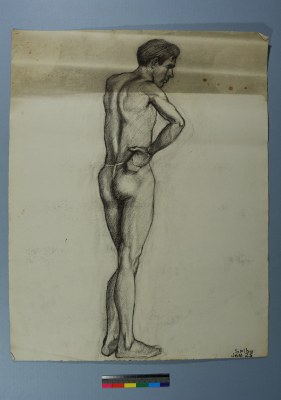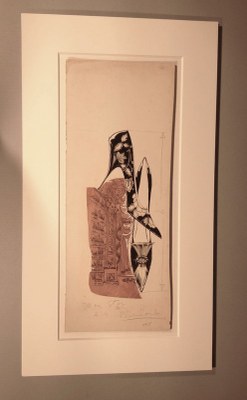
Plan your visit
Art is History
September 14, 2015

When many people think of the Indiana Historical Society, most minds often gravitate toward archives of the state?s history. This is true, but another aspect of its collection is the artwork of Indiana natives donated by them or their families. One such artist named Robert Hugo Selby has a collection that spans his years as an artist from studying at the John Herron Art Institute to the print ads designed while working as the art director for LS Ayres.
Robert Hugo Selby was born in Owensville on Jan. 31, 1909. He trained for six years at John Herron Art Institute under William Forsyth, Clifton Wheeler and Paul Hadley. Selby even married Forsyth?s daughter, Evelyn, in July 1940. In 1930, he was granted the Summer Study Scholarship to the Charles Hawthorn Cape School in Provincetown, Mass. After this experience, Selby went on to have his first exhibit at the Indiana Artist Exhibition in Indianapolis of the same year. He worked commercially at Marshall Studios and L.S. Ayres in Indianapolis, which is when his best-known work was created. After he left Ayres, he moved to New Jersey and worked for Hahne & Co. in Newark from 1958 to 1975. Selby then retired from advertising and moved to Austin, Tex., and continued painting and teaching watercolor for Life Time Learning Institute of Austin Community College.
This collection was brought to the conservation staff?s attention as needing to be re-housed in order to support the work, as well as keeping it stable for years to come.
The first thing that was done to accomplish this project was an inventory of every single piece to determine the type of media used. These included charcoal and graphite on paper, mixed media on board, watercolor on paper and board, oil on canvas, printed ads, chalk pastel, and some handwritten messages.
 The graphite on paper drawings and mixed media on board required buffered interleaving sheets between each individual work while watercolor paintings both on paper and board were interleaved with unbuffered sheets in order to create a pH neutral environment to protect against color change of the original media. Charcoal drawings were interleaved with archival transparent paper and, if the corners or edges were vulnerable, they were placed in Mylar sleeves. Printed ads were also placed in Mylar sleeves and those copied and printed were left alone. Pastel drawings were put in sink mats made of mat board in order to keep the friable media from smudging and spreading to other pieces in the same storage box.
The graphite on paper drawings and mixed media on board required buffered interleaving sheets between each individual work while watercolor paintings both on paper and board were interleaved with unbuffered sheets in order to create a pH neutral environment to protect against color change of the original media. Charcoal drawings were interleaved with archival transparent paper and, if the corners or edges were vulnerable, they were placed in Mylar sleeves. Printed ads were also placed in Mylar sleeves and those copied and printed were left alone. Pastel drawings were put in sink mats made of mat board in order to keep the friable media from smudging and spreading to other pieces in the same storage box.
After stabilizing the works for storage, it was important to address crucial problems that affected some pieces. A few charcoal drawings were significantly torn and repaired with wheat starch paste and Japanese tissue paper. The same method was applied to drawings with corners broken off from being handled over the years. Localized humidification was applied to folded edges in order to remove the creases and flatten them back out. Drawings that had mold residues were surface cleaned with vulcanized rubber, and soiled charcoals drawings were cleaned with Mars Staedtler eraser crumbs. A watercolor still life on board had bowed over the years and no longer was able to lie flat in the storage box. It was crucial that this piece would not be strained while resting so a deep sink mat was made to help provide a flat surface in storage.
An interesting part of the collection is the mixed media pieces on board. These are a sample of how advertising was done, cut and paste style, before the invention of technology and Photoshop programs. These pieces included ink, ink on paper, gouache highlighting, and notes in pencil about size and edits that needed to be made before being printed. Some of the various components were delaminated from their positions on the support board because the original adhesive had failed and lost its tack. In this instance, the components were re-adhered by using wheat starch paste and being put under weight until dry.
For the next couple years, there is a rotating exhibit of these works in the History Lab at the History Center. Each exhibit displays a personal work done by Robert Hugo Selby, a cut and paste sample of a potential printed ad with all the added details and suggestions, as well as a final ad that was passed around offices for approval before being printed.
____________________________________








